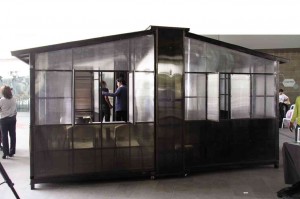
One hundred seventeen days after Supertyphoon “Yolanda,” sheltering the homeless remains a problem. Just launched at Mind Museum was the Butterfly House, a low-cost, foldable, steel-framed system that can be stretched out into a liveable structure.
“It is pre-assembled and takes less than 15 minutes to open up,” said architect Royal Pineda. “That’s why it’s called a Butterfly House. You don’t need a contractor, just three or four people to set it up.”
The Budji Layug + Royal Pineda firm has been asked to help in the rehabilitation of Leyte. Pineda has checked design solutions for homeless survivors, but none appealed to him until he met Filipino-American businessman Rogelio “Vonz” Santos Jr.
Santos, 33, owns businesses in technology, software engineering and pharmaceuticals. Last December, the Wall Street Journal featured him and other overseas Filipinos who had been organizing Yolanda relief efforts.
“I was motivated by the catastrophe,” said Santos. “So I rolled up my sleeves, spent my money, came up with a foldable house to prove it would work.”
At first he wanted to call it the “Flip House” because the concept was to turn over the parts of the house. But a friend pointed out that unfolding the panels and opening them to the roof and releasing the floor and walls looked like a butterfly unfolding its wings. Thus, the Butterfly House.
After developing two wooden prototypes, Santos approached the Budji Layug + Royal Pineda firm for its expertise. “They gave me the design concept and advice,” Santos said. “They worked with what I designed to make it presentable. We decided to feature the steel structure.”

Pineda found the concept striking: “We developed the idea and tweaked it until it could fly.”
Tropical design
The Buttefly House comes in three configurations. The one-room house of 11.5-sq m can comfortably fit a family of five. “It’s for a temporary shelter where people need a skin to protect them from the outside,” said Pineda.
Add a bathroom to the single unit, and it becomes a 15-sq m house.
The 26-sq m house, the standard size for socialized housing, is called the Monarch, after the king butterfly. The ceiling height is 2.6 meters, slightly higher than the height of condo units.
The Butterfly House’s framework is made sturdy with rectangular tubular steel bars. The roofing is galvanized steel with heat insulation foam to buffer the heat. The wall panels are a choice of bamboo, Hardiflex (building board), cement board and marine plywood.
“They are not conductive materials for heat,” said Pineda. “We put many windows so there is cross-ventilation to make it light and airy.”
Although designed for disaster response, the Butterfly House can become a permanent home once concrete is poured on the footprint.
As a portable system, its dimensions are 700-mm deep by 2,400-mm length and 2,600-mm high. “We want to keep it slim so we can put more in a 40-footer container van,” said Pineda.
The housing units are estimated to cost P50,000-P70,000 each.
The goal is to mass-produce them for bulk orders. The Department of Social Welfare and Development is said to have ordered 5,000 systems.
“We are talking to companies that are capable of producing volume, like 300 houses a month, with quality,” said Pineda. “Weight and affordability are crucial. We are trying to lessen the framework without losing the structural integrity. That is where engineering comes in.”
Corruption-proof
The Butterfly House Project is seeking organizations that are raising funds for shelter solutions in the Philippines. Pineda said that instead of giving cash, nongoverment organizations, companies and individuals can consider the purchase of a Butterfly House as a donation.
“Even with a good design, scarce materials and lack of skilled labor can result in a substandard product,” said Pineda.
“The solution is to manage everything in the factories in Manila with quality control. We avoid issues where products and materials are either scarce or expensive in the location. These
systems are delivered on site. Once you open and unfold it, you see a product of integrity.”
Another advantage of the Butterfly House System is that donors and buyers can oversee the production process and get a warranty. Every item could be easily accounted for.
“We are aiming for a corruption-proof product for NGOs and for people who want to donate,” said Pineda. “It’s not like funding a house where you will need a contractor, bid the purchase, deal with the local government and everybody gets a commission.”
Although the Butterfly House is durable, Pineda said it’s not typhoon-proof. Instead of confronting a storm, the system can be folded up and stored in a safe place while people evacuate. After the typhoon, the Butterfly House can be set up again.
Pineda and Santos said the house system could be used in underdeveloped countries where housing is scarce, and in high-risk or calamity areas where people may be displaced. It can transform into other applications such as a medical mission station, a greenhouse or an extra storage for the house.
“Abroad, we can incorporate a thermal wall and use a different roof,” said Pineda. “The design is meant to be universal.”
Call Rachelle Llanes at 0917-5611028; e-mail rachellellanes @amylexlabs.com.

